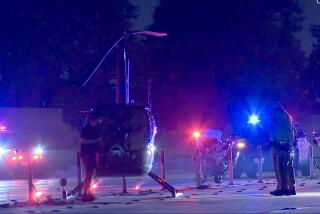Train Derails on Overpass, Shuts Freeway : Transportation: Rail cars tilting off tracks near Gardena threaten motorists below. Crews scramble, hoping to reopen 2-mile section of the Harbor roadway before the morning commute.
- Share via
Daniel Tarkington knew something was terribly wrong when he heard the sudden rush of air from the emergency brakes of his Southern Pacific freight train. A 35-year veteran of the railroad, Tarkington was all too familiar with the sound of a derailment.
“The train broke right in half,” said Tarkington, the conductor aboard a 16-car train that derailed Monday afternoon on a Harbor Freeway overpass during a severe rainstorm. “It happened at the worst possible place.”
Four railroad cars toppled from the tracks on the 149th Street railway bridge near Gardena, tilting precariously toward motorists below and forcing authorities to close a two-mile stretch of the freeway shortly after 1 p.m.
Caltrans officials predicted late Monday night that the freeway would reopen no earlier than 6 a.m. today and advised morning commuters to avoid the stretch between Redondo Beach Boulevard and Rosecrans Avenue, using Broadway or Main Street instead.
“We will be here around the clock trying to clear this, but there is always the chance that something could go wrong,” said Steve Leung, Caltrans chief of traffic management. “There are a lot of people and equipment involved.”
No one was injured in the mishap, but authorities estimated that more than 125,000 commuters were ensnarled in an afternoon-long traffic jam that extended for miles in both the northbound and southbound lanes of the freeway.
“We tried to get the message out, but there are still a zillion people just sitting out there in a parking lot,” said Officer Todd Sturges of the California Highway Patrol. “Shutting down a freeway is always a major nightmare, but our primary concern has to be the safety of the motorists.”
Caltrans engineers found no structural damage to the bridge, but authorities were being cautious because one of the derailed cars contained an estimated 160,000 pounds of sodium hydroxide, a hazardous corrosive that becomes extremely dangerous when mixed with water. None of the material, also known as lye, leaked from the tanker, but the chemical was to be drained into trucks early this morning before the derailed cars would be righted by 100-foot cranes.
Mike Irvine, director of field operations for Southern Pacific, said the derailment was caused when tons of gravel and dirt gave way beneath a 25-foot span of railroad tracks just east of the 149th Street bridge. About 300 tons of replacement gravel was being hauled to the site late Monday night to reinforce the eroded section, he said.
Los Angeles fire officials said the dirt beneath the tracks was swept away--much of it cascading onto the northbound Harbor Freeway--by a gush of water from nearby Figueroa Street. Fire crews erected barricades of sand and railroad ties to divert the flow of storm water back to the roadway.
“The tracks were acting like a funnel for the water,” said Fire Department spokesman Phil Weireter.
Tarkington said an inspection car that checked the track about 90 minutes before the derailment found no evidence of a washout, leading him to believe that vibrations from the train caused the water-weakened section to give way. Eleven of the train’s 16 cars passed the span before the derailment occurred, he said.
The train was traveling 5 m.p.h., about half its normal speed, on its regular daily route from downtown Los Angeles to Torrance with a cargo of steel, lumber and lye, Tarkington said. Standing in knee-high rubber boots and a white rain hat, the Rancho Palos Verdes resident said crews were doing their best to get the derailed cars righted.
“I have to take the Harbor Freeway home,” he said.
More to Read
Sign up for Essential California
The most important California stories and recommendations in your inbox every morning.
You may occasionally receive promotional content from the Los Angeles Times.













